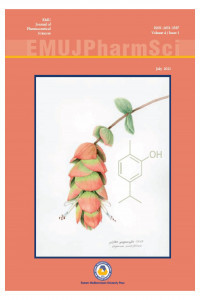Urolithins and their antimicrobial activity: A short review
Urolithins and their antimicrobial activity: A short review
In the last few decades, the rate of the production of new antibiotic has declined significantly. This is mainly due to the high costs needed for both research and development processes. On the other hand, antibacterial resistance developed by bacteria against the already present antibiotics has been increasing extensively. Thus, finding alternatives to synthesize new antimicrobial molecules is now a priority to fight against resistant bacteria. One of these alternatives that can be used as precursors for new antimicrobial molecules is secondary metabolites. Ellagitannins, abundantly found in walnut, pomegranate, and berries, are known as precursors of ellagic acid which possess antimicrobial, anticancer, and antioxidant activities. Ellagic acid is metabolized in mammalian gastrointestinal system via gut microbiota to form dibenzo [b, d] pyran-6-one metabolites, which are known as urolithins. Urolithins are the metabolites of ellagic acid which are responsible for its biological activities. There are many types of urolithins such as urolithin A, urolithin B, urolithin C and urolithin D that were detected in mammalian gastrointestinal tract. Urolithins were shown to possess antimicrobial activity against bacteria, viruses and fungi. In this article, it was aimed to review the antimicrobial activities of various natural and synthetic urolithins concomitant to their chemistry.
Keywords:
Antimicrobial activity, ellagic acid ellagitannins, gut microbiota, urolithins,
___
- Bialonska D, Ramnani P, Kasimsetty SG, Muntha KR, Gibson GR, Ferreira D (2010). The influence of pomegranate by-product and punicalagins on selected groups of human intestinal microbiota. Int J Food Microbiol 140(2-3): 175-82.
- Chung JG (1998). Inhibitory actions of ellagic acid on growth and arylamine N-acetyltransferase activity in strains of Helicobacter pylori from peptic ulcer patients. Microbios 93(375): 115–127.
- Clifford MN (2000). Ellagitannins - Nature, occurrence and dietary burden. J Sci Food Agric 80: 1118-1125.
- Espín JC, Larrosa M, García-Conesa MT, Tomás-Barberán Espín F (2013). Biological significance of urolithins, the gut microbial ellagic acid-derived metabolites: The evidence so far. Evid Based Complement Alternat Med 270418.
- Gajdács M (2019). The concept of an ideal antibiotic: Implications for drug design. Molecules 24(5): 892.
- Garazd YL, Garazd MM (2016). Natural Dibenzo[b,d]Pyran-6-Ones: Structural diversity and biological activity. Chemistry of Natural Compounds 52(1): 1–18.
- Gaynes R (2017). The discovery of penicillin—new insights after more than 75 years of clinical use. Emerg Infect Dis 23(5): 849–853. Giménez-Bastida JA, Truchado P, Larrosa M, Espín JC, Tomás-Barberán FA, Allende A, García-Conesa MT (2012). Urolithins, ellagitannin metabolites produced by colon microbiota, inhibit Quorum Sensing in Yersinia enterocolitica: Phenotypic response and associated molecular changes. Food Chem 132(3): 1465–1474.
- Hayriye CK (2011). Evaluation of Natural Antimicrobial Phenolic Compounds Against FoodborneEvaluation of Natural Antimicrobial Phenolic Compound. University of Kentucky Master’s Theses.
- Junaid A, Rafiq QA, Ratcliffe E (2018). Antimicrobial resistance mechanisms and potential synthetic treatments. Future Science OA 4(4).
- Landete JM (2011). Ellagitannins, ellagic acid and their derived metabolites: A review about source, metabolism, functions and health. Food Research International. 44(5): 1150–1160.
- Lipińska L, Klewicka E, Sójka M (2014). Structure, occurrence and biological activity of ellagitannins: A general review. Acta Sci Pol Technol Aliment 13(3): 289–299.
- Scalbert A (1991). Antimicrobial properties of tannins. Phytochemistry 30(12): 3875–3883.
- Simões M, Bennett RN. Rosa, EAS. (2009). Understanding antimicrobial activities of phytochemicals against multidrug resistant bacteria and biofilms. Nat Prod Rep 26(6): 746–757.
- Smith M (2017). Antibiotic Resistance Mechanisms. Journeys in Medicine and Research on Three Continents Over 50 Years : 95–99.
- Tomás-Barberan FA, Espín JC, García-Conesa MT (2009). Bioavailability and metabolism of ellagic acid and ellagitannins. In: Chemistry and Biology of Ellagitannins, An Underestimated Class of Bioactive Plant Polyphenols. pp: 273–297.
- Yoshida T, Hatano T, Ito H, Okuda T (2009). Structural diversity and antimicrobial activities of ellagitannins. In: Chemistry and Biology of Ellagitannins: An Underestimated Class of Bioactive Plant Polyphenols. pp. 55–93.
- Yuzugulen J, Noshadi B, Shukur K, Sahin MF, Gulcan HO (2019). The metabolites of ellagitannin metabolism urolithins display various biological activities. EMUPharmSci 2(2): 102–110.
- ISSN: 2651-3587
- Başlangıç: 2018
- Yayıncı: Doğu Akdeniz Üniversitesi
Sayıdaki Diğer Makaleler
Evaluation of the recommended treatment and preventive measures of COVID-19
Hananeh KORDBACHEH, Ahmet AYDIN, Sonia SANAJOU, Gönül ŞAHİN
Urolithins and their antimicrobial activity: A short review
Omar AMMAR, Mehmet İLKTAÇ, Hayrettin Ozan GÜLCAN
Emine Dilek ÖZYILMAZ, Tansel ÇOMOĞLU, Roya NOURMOHAMMADİ
Lamiaceae in Turkey: Additional taxa 2000-2019
Neriman ÖZHATAY, Şükran KÜLTÜR, Bahar GÜRDAL
A study on life expectancy in Turkey
Negar KHEZRİ, E. Vildan BURGAZ
The genus Persicaria (Polygonaceae) in Turkey with a new taxon record
